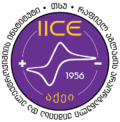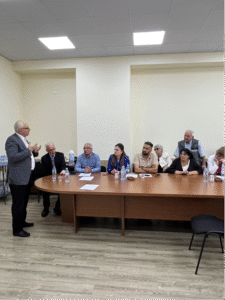On January 31, 2024, in the assembly hall of the R. Agladze Institute of Inorganic Chemistry and Electrochemistry of Ivane Javakhishvili Tbilisi State University, was held a seminar, where the Leader, Dr. Nikoloz Nioradze, reported to the audience on the intermediate results of the research grant project FR-22-11993 “Development of 3D biohybrid electrodes and their potential application in photoactive supercapacitors”, funded by the LEPL Shota Rustaveli National Science Foundation of Georgia.
The scientific community is increasingly interested in innovative methods for exploitation the continuous and abundant resource of solar energy for energy conversion and storage. Technologies studied in this context include photovoltaic (PV) systems, photocatalytic processes, photorechargeable batteries, and various optoelectronic devices. It is worth noting that the direct use of solar radiation is hampered by its irregular and intermittent nature, which limits the effective utilization of its full energy potential. Integrating solar energy collection, conversion, and storage into a single compact device would be an important step towards solving this problem.
The project aimed to develop and test materials that could potentially be of interest for use in photosensitive supercapacitor devices. This is a hybrid system that combines the properties of photovoltaic cells and supercapacitors to simultaneously provide light-based energy conversion and electrochemical energy storage. The aim of this work is to fabricate a photoelectrochemically active electrode based on indium tin oxide (ITO) glass, modified with manganese oxide/carbon particles (Mn₂O₃/C), titanium dioxide (TiO₂) and an electropolymerized polyaniline (PANI) surface layer.
Despite the direct use of sunlight, its irregular periodicity affects the energy yield, and thus a huge energy potential remains untapped. Given this fact, the collection, conversion and storage of solar energy in a single, compact device is of great importance for long-term uninterrupted power supply. In this context, new systems, so-called photosupercapacitors (PSCs), which simultaneously provide photovoltaic conversion of solar energy and energy storage (therefore, combining PV and supercapacitors), have recently been developed.
The project connects several disciplines: energy, chemistry (inorganic, organic), photochemistry, materials science. Thus, within the framework of the project, developments related to these disciplines have taken place. In particular, the development of photoactive systems should be highlighted, which is not a frequent occurrence in the Georgian scientific field.
The progress of the project and the data obtained as a result of the experiments attracted the interest of the audience. Further plans for research within the project were discussed. A number of interesting opinions were expressed regarding the experimental part of the study aimed at testing new approaches.



